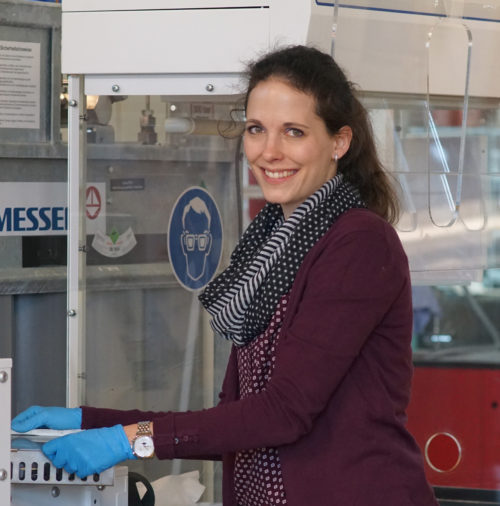/ News, Portraits
Functional surfaces for fascinating effects

Sonja Neuhaus heads research group in the School of Engineering
Dr Sonja Neuhaus is fascinated by the possibilities offered by functionalized surfaces. In several Argovia projects, she has used her enthusiasm and knowledge of modified polymer surfaces to achieve different effects depending on the application. The young materials scientist is also a good example of how a flexible employer can help its staff to achieve a good balance between work and family.
Getting to the bottom of things
Sonja Neuhaus has been interested in science since she attended the cantonal school in Aarau. When she read about the degree in materials science in an issue of “Perspektiven”, she was immediately hooked. Participating in “Jugend forscht”, which led her to the Federal Institute of Technology Zurich, confirmed her first impression that this interdisciplinary program was the perfect choice. During her studies in Zurich, she was particularly fascinated by material-related subjects and polymer chemistry. She spent the third year of her Bachelor’s degree at the EPF in Lausanne. “That was a good change of scenery for me,” Sonja remembers. “And it became clear during this time that what really interested me was getting to the bottom of questions and researching them in the lab.” After completing her master’s, she immediately began a doctoral thesis at the Paul Scherrer Institute (PSI) investigating the functionalization of polymer surfaces.
Ideal combination at the FHNW
Before she had even completed her doctorate, Sonja Neuhaus was using online portals to tackle the next stage in her career. It was not long before she found a position at Glas Trösch that sounded exciting and was a perfect fit. “After my PhD I wanted to work in industry – to see what research produces,” she comments. From 2011 to 2013, she worked as a project manager on new glass coating procedures at Glas Trösch in Bützberg. However, she didn’t find this work entirely fulfilling, and sometimes missed having the independence to make her own decisions in the industrial environment. Right on cue, a contact at the PSI told her about a vacancy at the Institute of Polymer Nanotechnology. The job seemed made for Sonja Neuhaus. “I switch between industry and basic research depending on the project. This is where I feel most comfortable,” says Sonja about her recent years at the FHNW. Here, she can conduct research while maintaining links with the application side and contact with the industry.
Functionalized polymer surfaces are the goal
Most projects are conducted in collaboration with Swiss SMEs, and Sonja Neuhaus has also been involved in some SNI Argovia projects in the last few years. Her research projects generally revolve around modifications to polymer surfaces without altering volume properties. To achieve this, various procedures are used to bond molecules and polymers to the surfaces, resulting in chemical functionalization. Depending on the problem to be solved, the polymers acquire new properties such as a water-repellent surface. As the manager of the RepAll project, she and her team investigated, for example, how polymer surfaces can be structured and chemically modified to ensure less adhesion and better run-off for various liquids. In the SurfFlow Argovia project, completed in 2016, the project team examined how the surface of polymer lenses can be smoothed for optical applications without altering the form or deeper layers. Another project focused on preventing the surfaces of cable materials from sticking together when coiled. In one fascinating project, color effects in security features were achieved via micro- and nano structuring.
Totally new requirements
The 33-year-old scientist faced a very different challenge around a year and a half ago, when she became a mother. Despite becoming the group leader for surface functionalization around the same time, Sonja was able to reduce her workload, allowing her to find a good balance between family and work. As she says herself, she has found the right place for her and, with plenty of dedication and enthusiasm, has overcome all possible obstacles to drive her research forward and continuously identify innovative approaches to surface functionalization.
